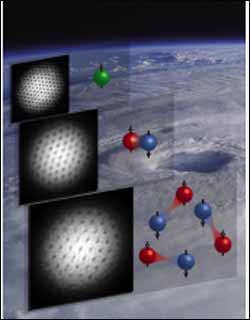MIT Group Creates a High-Temperature Superfluid

The vortices observed in three rotating superfluids superimposed on the eye of a hurricane
Physicists at the Massachusetts Institute of Technology (MIT) have created the first example of a high-temperature superfluid: a new state of matter in which the atoms in a gas can move with no friction or slowing down whatsoever.
Reported in the June 23 issue of journal Nature, the work is closely related to the superconductivity of electrons in metals. According to Wolfgang Ketterle, the Nobel laureate who heads the MIT group, observations of superfluids may help solve lingering questions about high-temperature superconductivity, which has widespread applications for magnets, sensors and energy efficient transport of electricity.
“In superfluids, as well as in superconductors, particles move in lockstep,” explains Ketterle. “They form one big quantum-mechanical wave.” Such a movement allows superconductors to carry electrical currents without resistance.
The MIT research was carried out at the MIT-Harvard Center for Ultracold Atoms, which is funded by the National Science Foundation (NSF), and received direct support from NSF, the Office of Naval Research, the National Aeronautics and Space Administration, and the Army Research Office.
For more information, see the MIT news release.
Media Contact
All latest news from the category: Physics and Astronomy
This area deals with the fundamental laws and building blocks of nature and how they interact, the properties and the behavior of matter, and research into space and time and their structures.
innovations-report provides in-depth reports and articles on subjects such as astrophysics, laser technologies, nuclear, quantum, particle and solid-state physics, nanotechnologies, planetary research and findings (Mars, Venus) and developments related to the Hubble Telescope.
Newest articles

A universal framework for spatial biology
SpatialData is a freely accessible tool to unify and integrate data from different omics technologies accounting for spatial information, which can provide holistic insights into health and disease. Biological processes…

How complex biological processes arise
A $20 million grant from the U.S. National Science Foundation (NSF) will support the establishment and operation of the National Synthesis Center for Emergence in the Molecular and Cellular Sciences (NCEMS) at…

Airborne single-photon lidar system achieves high-resolution 3D imaging
Compact, low-power system opens doors for photon-efficient drone and satellite-based environmental monitoring and mapping. Researchers have developed a compact and lightweight single-photon airborne lidar system that can acquire high-resolution 3D…





















